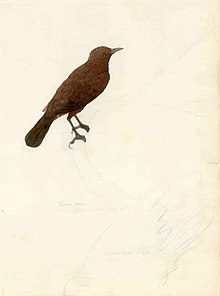
The blue rock thrush is a species of chat. This thrush-like Old World flycatcher was formerly placed in the family Turdidae. It breeds in southern Europe, northwest Africa, and from Central Asia to northern China and Malaysia. The blue rock thrush is the official national bird of Malta and was shown on the Lm 1 coins that were part of the country's former currency.
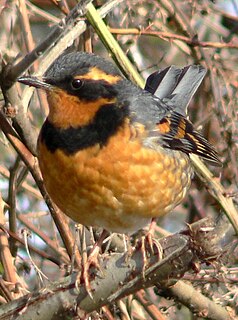
The varied thrush is a member of the thrush family, Turdidae. It is the only species in the monotypic genus Ixoreus.
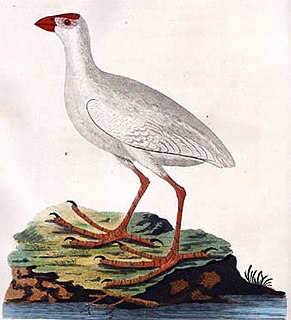
The white swamphen, also known as the Lord Howe swamphen, Lord Howe gallinule or white gallinule, is an extinct species of rail which lived on Lord Howe Island, east of Australia. It was first encountered when the crews of British ships visited the island between 1788 and 1790, and all contemporary accounts and illustrations were produced during this time. Today, two specimens exist: the holotype in the Natural History Museum of Vienna, and another in Liverpool's World Museum. Although historical confusion has existed about the provenance of the specimens and the classification and anatomy of the bird, it is now thought to have been a distinct species endemic to Lord Howe Island and most similar to the Australasian swamphen.

The Tahiti sandpiper or Tahitian sandpiper is an extinct member of the large wader family Scolopacidae that was endemic to Tahiti in French Polynesia.
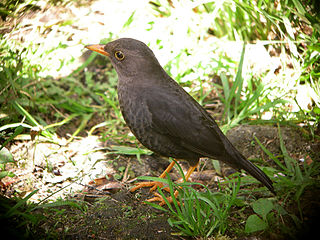
The island thrush is a common forest bird in the thrush family. Almost 50 subspecies have been described, ranging from Taiwan, through South East Asia and Melanesia, to Samoa, exhibiting great differences in plumage. Several subspecies are threatened and three have already become extinct.

The hoopoe starling, also known as the Réunion starling or Bourbon crested starling, is a species of starling that lived on the Mascarene island of Réunion and became extinct in the 1850s. Its closest relatives were the also-extinct Rodrigues starling and Mauritius starling from nearby islands, and the three apparently originated in south-east Asia. The bird was first mentioned during the 17th century and was long thought to be related to the hoopoe, from which its name is derived. Some affinities have been proposed, but it was confirmed as a starling in a DNA study.
The Mauke starling or mysterious starling was a species of starling found on the island of Mauke, Cook Islands. It is now extinct. The binomen is the result of Buller's misreading of the name inornata on the specimen label. As he seems to have genuinely believed this spelling to be correct, the binomial, although it has no meaning, is valid.

The Tanna ground dove, also known as Forster's dove of Tanna, is an extinct dove species. Its taxonomic affiliation is uncertain but at its first scientific discussion by Johann Georg Wagler in 1829 it was classified into the genus Gallicolumba ; its closest relative is possibly the Santa Cruz ground dove. It was endemic to the Pacific island of Tanna, Vanuatu. Forster records a native name mahk, almost certainly from the Kwamera language.

The Tahiti rail, Tahitian red-billed rail, or Pacific red-billed rail is an extinct species of rail that lived on Tahiti. It was first recorded during James Cook's second voyage around the world (1772–1775), on which it was illustrated by Georg Forster and described by Johann Reinhold Forster. No specimens have been preserved. As well as the documentation by the Forsters, there have been claims that the bird also existed on the nearby island of Mehetia. The Tahiti rail appears to have been closely related to, and perhaps derived from, the buff-banded rail, and has also been historically confused with the Tongan subspecies of that bird.
The Grand Cayman thrush is an extinct bird from the thrush family (Turdidae). It was endemic to the island of Grand Cayman in the Caribbean.
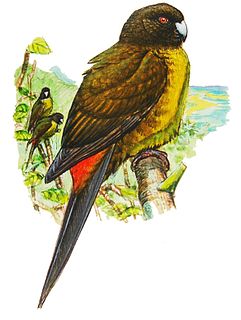
The Raiatea parakeet or Society parakeet, also known as the Society kakariki or brown-headed parakeet, is an extinct parakeet of the genus Cyanoramphus.

The Kosrae starling, also known as Kosrae Island starling, and formerly as Kusaie Mountain starling, is an extinct bird from the family of starlings (Sturnidae). It was endemic to the montane forests on the island of Kosrae which belong to the Caroline Islands in the south-western Pacific.

The Pohnpei starling, also known as Pohnpei mountain starling or Ponape mountain starling, is an extremely rare or possibly extinct bird from the family of starlings (Sturnidae). It is endemic to the island of Pohnpei in the Pacific Ocean. It was called "sie" by the Pohnpei islanders. It was named after the Austrian ornithologist August von Pelzeln (1825–1891).

The Norfolk starling, was a small bird in the starling family. It is the extinct nominate subspecies of the Tasman starling, the only other subspecies being the also-extinct Lord Howe starling.

The Lord Howe starling was a small bird in the starling family. It is an extinct subspecies of the Tasman starling, the only other subspecies being the Norfolk starling which is also extinct. It was endemic to Lord Howe Island in the Tasman Sea, part of New South Wales, Australia.

The long-tailed starling is a species of starling in the family Sturnidae. It is endemic to the Schouten Islands off West Papua, in Indonesia, an important area of bird endemism. The species was once treated as part of a superspecies with the shining starling. There are two subspecies, the nominate race, which occurs on Biak, and brevicauda, which is found on Numfor Island. It occurs in a wide range of habitats at all altitudes, including natural forest and forest edges, as well as human modified secondary forests and gardens. In spite of its tiny global range the species is not considered threatened by human activities and remains common within its range, and is therefore listed as least concern by the IUCN.

The spotted green pigeon or Liverpool pigeon is a species of pigeon which is most likely extinct. It was first mentioned and described in 1783 by John Latham, who had seen two specimens of unknown provenance and a drawing depicting the bird. The taxonomic relationships of the bird were long obscure, and early writers suggested many different possibilities, though the idea that it was related to the Nicobar pigeon prevailed, and it was therefore placed in the same genus, Caloenas. Today, the species is only known from a specimen kept in World Museum, Liverpool. Overlooked for much of the 20th century, it was recognised as a valid extinct species by the IUCN Red List only in 2008. It may have been native to an island somewhere in the South Pacific Ocean or the Indian Ocean, and it has been suggested that a bird referred to as titi by Tahitian islanders was this bird. In 2014, a genetic study confirmed it as a distinct species related to the Nicobar pigeon, and showed that the two were the closest relatives of the extinct dodo and Rodrigues solitaire.
The Huahine starling is an extinct bird from the genus Aplonis within the starling family, Sturnidae. It was endemic to the island of Huahine, in the Society Islands of French Polynesia, and therefore had the easternmost distribution of all Aplonis species in the Pacific region.
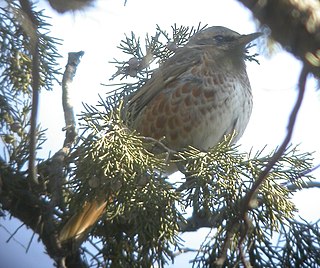
Naumann's thrush is a member of the thrush family Turdidae which breeds eastwards from central Siberia to North Manchuria, Amurland and Sakhalin. It is closely related to the more northerly breeding dusky thrush T. eunomus; the two have often been regarded as conspecific.
